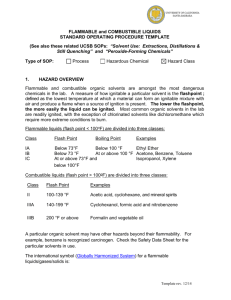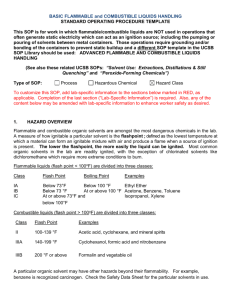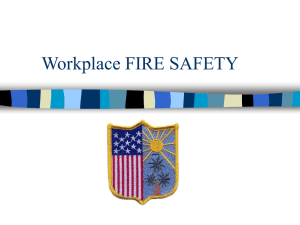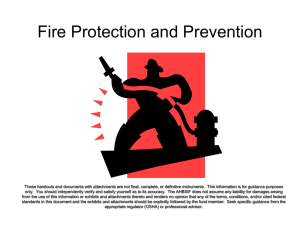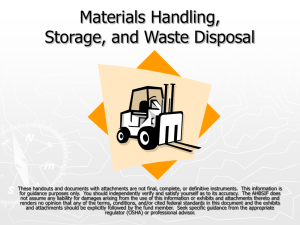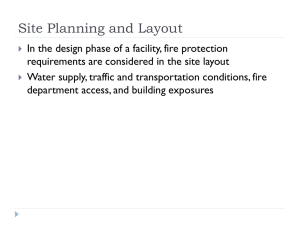Flammable and combustible organic solvents are amongst the most
advertisement
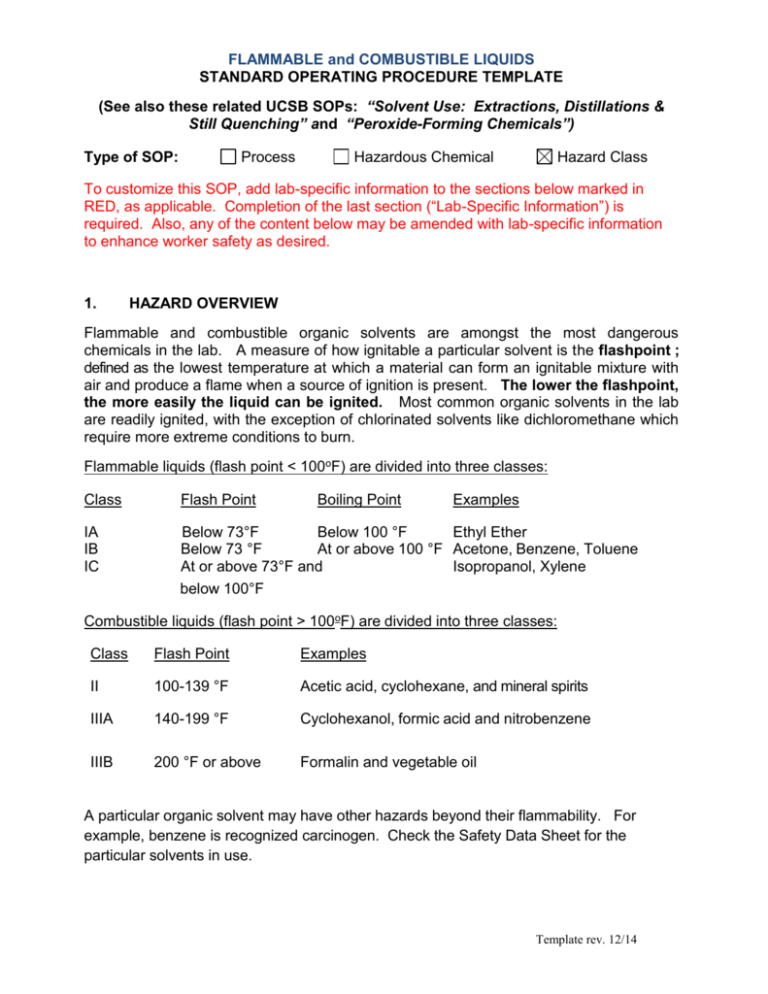
FLAMMABLE and COMBUSTIBLE LIQUIDS STANDARD OPERATING PROCEDURE TEMPLATE (See also these related UCSB SOPs: “Solvent Use: Extractions, Distillations & Still Quenching” and “Peroxide-Forming Chemicals”) Type of SOP: Process Hazardous Chemical Hazard Class To customize this SOP, add lab-specific information to the sections below marked in RED, as applicable. Completion of the last section (“Lab-Specific Information”) is required. Also, any of the content below may be amended with lab-specific information to enhance worker safety as desired. 1. HAZARD OVERVIEW Flammable and combustible organic solvents are amongst the most dangerous chemicals in the lab. A measure of how ignitable a particular solvent is the flashpoint ; defined as the lowest temperature at which a material can form an ignitable mixture with air and produce a flame when a source of ignition is present. The lower the flashpoint, the more easily the liquid can be ignited. Most common organic solvents in the lab are readily ignited, with the exception of chlorinated solvents like dichloromethane which require more extreme conditions to burn. Flammable liquids (flash point < 100oF) are divided into three classes: Class Flash Point Boiling Point Examples IA IB IC Below 73°F Below 100 °F Ethyl Ether Below 73 °F At or above 100 °F Acetone, Benzene, Toluene At or above 73°F and Isopropanol, Xylene below 100°F Combustible liquids (flash point > 100oF) are divided into three classes: Class Flash Point Examples II 100-139 °F Acetic acid, cyclohexane, and mineral spirits IIIA 140-199 °F Cyclohexanol, formic acid and nitrobenzene IIIB 200 °F or above Formalin and vegetable oil A particular organic solvent may have other hazards beyond their flammability. For example, benzene is recognized carcinogen. Check the Safety Data Sheet for the particular solvents in use. Template rev. 12/14 The international symbol (Globally Harmonized System) for a flammable liquids/gases/solids is: Diethyl ether initiated fire 2. PERSONAL PROTECTIVE EQUIPMENT (PPE) See the PPE information under Sec. II of the UCSB Chemical Hygiene Plan regarding: the UC PPE Policy and policy summary (what PPE is needed and when/where to use) obtaining your PPE via use of the Laboratory Hazard Assessment Tool (LHAT) glove selection criteria respirator use, etc. In general, workers who use flammable liquids will be issued a free fire-resistant Nomex lab coat via the LHAT process. 3. ENGINEERING/VENTILATION CONTROLS All chemicals should be transferred and used in an annually certified laboratory chemical fume hood with the sash at the certified position or lower. The hood flow indicator should be checked to be operating correctly prior to using the hood. For further information see the following pages in Sec. II of the UCSB Chemical Hygiene Plan: Fume Hood Usage Guide Criteria for Implementing Engineering Controls Safety Shielding: Shielding is required any time there is a significant risk of explosion, splash hazard or a highly exothermic reaction. All manipulations of flammable liquids which pose this risk should occur in a fume hood with the sash in the lowest feasible position. Portable shields, which provide protection to all laboratory occupants, are acceptable. Special Ventilation: Manipulation of flammable liquids outside of a fume hood may require special ventilation controls in order to minimize exposure and reduce the fire risk. Fume hoods provide the best protection against exposure to flammable liquids in the laboratory and are the preferred ventilation control device. If your research 2 does not permit the handing of large quantities of flammable liquids in your fume hood, contact EH&S to review the adequacy of all special ventilation. 4. SPECIAL HANDLING PROCEDURES AND STORAGE REQUIREMENTS Use in an area that is properly equipped with a certified eye wash and safety shower that is available within ten seconds of travel. Store in a tightly closed, labeled container and in a cool, dry, well-ventilated area. Segregate from incompatible materials. Repackaged chemicals must be labeled clearly. For example, squirt bottles and acid/base cleaning baths. Follow any substance-specific storage guidance provided in Safety Data Sheet documentation. Flammable Liquid Storage Cabinets One or more Flammable Liquid Storage Cabinets (FLSC) are required by CA Fire Code for laboratories which store, use or handle more than 10 gallons of flammable or combustible liquids. Containers of flammable liquids that are one gallon and larger must be stored in a flammable-liquids storage cabinet. The storage of flammable and combustible liquids in a laboratory, shop, or building area must be kept to the minimum needed for research and/or operations. FLSC are not intended for the storage of highly toxic materials, acids, bases, compressed gases, or pyrophoric chemicals. In most UCSB laboratories, flammable liquids storage is provided under the chemical fume hood. These cabinets are clearly marked “Flammable Storage” and are often ventilated via a stainless steel hose into the fume hood exhaust duct. Flammable liquids storage cabinets are constructed to limit the internal temperature when exposed to fire. When additional storage is needed, NFPAapproved FLSC may be purchased. All containers of flammable liquids must be stored in a FLSC when not in use. The following requirements apply: General Requirements o Cabinets shall be marked “Flammable - Keep Fire Away” o Cabinets should be kept in good condition. Doors that do not close and latch must be repaired or the cabinet must be replaced. Flammable liquids storage cabinets are equipped with a grounding system that can be connected to a building ground. If you are pouring from a container in the storage cabinet and if the container being poured into is conductive then a bonding strap must be attached between them as explained in PROCEDURES TO AVOID STATIC ELECTRICITY. FLSC involved in fire 3 Transferring/Dispensing STATIC ELECTRICITY HAZARDS IN THE LABORATORY The flow of flammable and combustible liquids can cause the buildup of static electricity. When enough of a charge is built up a spark can result and potentially cause a fire or explosion. The likelihood of this happening is dependent upon how well the liquid conducts electricity, the flash point, and the capacity to generate static electricity. Static electricity can be generated when liquid is transferred from one metal container to another. Liquids have the ability to generate static electricity when they move in contact with other materials during pouring, pumping, or agitating. The buildup of this static electricity can cause a spark to form where the solvent exits the container. This could result in a fire or explosion. PROCEDURES TO AVOID STATIC ELECTRICITY To avoid the buildup of static electricity that may cause a spark, it is important to bond and ground metal containers, particularly for larger quantities, e.g. 55 or 5 gal. drums. Bonding eliminates the electrical potential between two containers, therefore eliminating the likelihood of sparks. A bonding wire is connected to two conductive objects as seen in the drums pictured below. Bonding wires between drums Grounding eliminates the difference in static potential charge between the conductive object and ground. Grounding is accomplished by connecting the conductive object directly to the earth, usually using cold water copper pipes, building steel, or a grounding bus/bar. 4 Bonding and grounding require good electrical connections. Remove any dirt, paint or rust, ensuring metal to metal contact. Building Static Grounding “Bus” (Mounted on Wall) Small Grounding Clamp Attached to Portable Solvent Container Cable of Sufficient Length Portable Container 5 Bonding and Grounding wires come in a variety of styles/lengths. They can be purchased through Fisher Scientific:, Justrite Manufacturing: and through Lab Safety Supply: Hand Clamp ‘C’ Clamp and Alligator Clip Static hazards may also exist in non-metallic plastic or glass containers that cannot be grounded. Static may be generated by the free fall and turbulence of the liquid being poured. To minimize this hazard, pour as slowly as possible and use a grounded nozzle extension that allows filling the container from the bottom. DISPENSING FLAMMABLE LIQUIDS FROM 5 GALLON PAILS Manual dispensing pumps for 5-gallon pails/cans are available. These pumps are specifically designed to dispense liquids into small laboratory-size bottles without spilling. If you are pouring into a conductive container, a bonding wire should be attached from the 5-gallon pail to the container being filled. The 5-gallon pail should be grounded. Template rev. 12/14 The dispenser shown in the picture below can be purchased through Fisher Scientific.The metal strap in the picture hooks over the bottom of the pail and secures the dispenser while pumping. Metal Strap Two adapters are provided with the dispensing pump from Fisher (grey and black). Use the appropriate adapter to achieve the correct seal with the solvent container you have. Some solvent containers have a grey fitting at the opening, and others have a black one. DISPENSING FLAMMABLES FROM SAFETY CANS Safety cans have self-closing air tight lids and a flame arrestor that protects the contents from an external ignition source. Bonding and grounding is still required on safety cans since static electricity generation is possible. The nozzle provides a bonding path to a receiving metallic vessel. If either of the containers is non-metallic (non-conductive) it is still important to follow the limited velocity and grounded nozzle extension information given previously. Flammable Liquids SOP Page 7 of 10 Safety Can with extended nozzle Safety cans do not offer protection from heat when exposed to fire and should be stored in a flammable liquids storage cabinet when not in use. Labeling All flammable liquids must be clearly labeled with the correct chemical name. Handwritten labels are acceptable; chemical formulas and structural formulas are not acceptable. The label on any containers of flammable liquids should say “Flammable” and should include any other hazard information, such as “Corrosive” or “Toxic”, as applicable. Example: lab squirt bottles, or acid/base baths. Heating/Open flame Do not permanently store flammable liquids in chemical fume hoods or allow containers of flammable liquids in proximity to heating mantles, hot plates, or torches. With the exception of vacuum drying ovens, laboratory ovens rarely have any means of preventing the discharge of material volatilized within them. Thus it should be assumed that these substances will escape into the laboratory atmosphere, but may also be present in sufficient concentration to form explosive mixtures within the oven itself. Venting the oven to an exhausted system will reduce this hazard. Drying ovens should not be used to dry glassware that has been rinsed with organic solvents until all of the solvent has had the opportunity to drain or evaporate at room temperature. Flammable Liquids SOP Page 8 of 10 5. SPILL AND INCIDENT PROCEDURES See directions under the “Chemical Incident” and “Medical Emergency” tabs of the UCSB Emergency Information Flipchart – should already be posted in all labs. For those that routinely use flammable liquids, it is strongly recommended that they attend the live version of the EH&S Fundamentals of Laboratory Safety class, where hands-on fire extinguisher training is conducted. All campus labs should have a fire extinguisher already on-site, generally near the exit door. 6. DECONTAMINATION Wear proper PPE, decontaminate equipment and bench tops using [soap and water]. Dispose of all used contaminated disposables as hazardous waste per below. 7. WASTE DISPOSAL See “Chemical Waste Disposal” in Sec. II of the UCSB Chemical Hygiene Plan. 8. PRIOR APPROVAL/REVIEW REQUIRED As they deem necessary, the PI/supervisor should insert here any prior approval or review needed, before an individual can do the operation. 9. DESIGNATED AREA As they deem necessary, the PI/supervisor should insert here any information about whether a special use-area is designated for this material/process. Work should be completed in a laboratory fume hood given the volatility and flammability of most solvents. 10. SAFETY DATA SHEETS and OTHER REFERENCES Online SDS can be found at: http://ehs.ucsb.edu/labsafety/msds Prudent Practices in the Laboratory, 2011, see Secs. 4.D and 6.F for flammable liquids http://www.nap.edu/openbook.php?record_id=12654&page=R15 Flammable Liquids SOP Page 9 of 10 11. LAB-SPECIFIC INFORMATION (required) (Examples of appropriate content) Add appropriate lab-specific information here describing how this material(s) is generally used. E.g., name of protocol, typical frequency done, quantities used, temperature and any additional safety measures, etc. Flammable Liquids SOP Page 10 of 10
